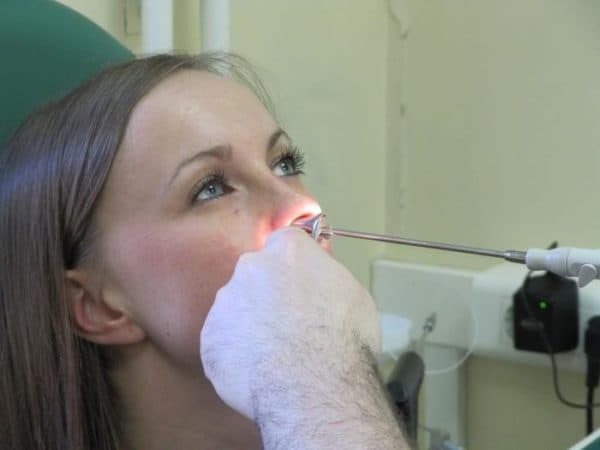
An endless companion of colds is the common cold, or, in scientific terms, rhinitis. It is also a mandatory manifestation of allergy and the body's reaction to the presence in the atmosphere of harmful and irritating factors. We are used to not pay much attention to this annoying and not very comfortable symptom, often not treating it and starting the process on its own. And in vain! An untreated rhinitis can eventually develop into a chronic form and "please" the patient for the rest of his life. Moreover, it can lead to serious complications. One of the extremely unpleasant forms of such a neglected rhinitis will be discussed below.
Content
- 1 What is hypertrophic rhinitis
- 2 Classification
- 3 causes and predisposing factors
- 4 Symptoms and signs
- 5 Diagnostics
- 6 Therapies
- 6.1 Folk remedies
- 6.2 Conservative therapies
- 6.3 Surgical treatment
- 7 Consequences and complications
- 8 Video
What is hypertrophic rhinitis
 Hypertrophic rhinitis is a form of chronic rhinitis characterized by pathological proliferation of nasal cavity tissues. Basically, we are talking about the mucosa and the submucosa, but sometimes the periosteum, as well as the bone structures, can be involved in the process. Because of the excessive development of the interior of the nose, there is a severe difficulty in breathing, until the nasal passages completely overlap. Suffering suffers, the general state of health also becomes far from ideal.
Hypertrophic rhinitis is a form of chronic rhinitis characterized by pathological proliferation of nasal cavity tissues. Basically, we are talking about the mucosa and the submucosa, but sometimes the periosteum, as well as the bone structures, can be involved in the process. Because of the excessive development of the interior of the nose, there is a severe difficulty in breathing, until the nasal passages completely overlap. Suffering suffers, the general state of health also becomes far from ideal.
This pathology requires increased attention and urgent treatment. Its distinctive feature is the low effectiveness of medicines, in most cases the disease requires surgical intervention of varying degrees of invasiveness.
Classification
The mechanism of the occurrence and extent of rhinitis, diseases classified as follows:
| Rhinitis | ||||
| Infection | Non-infectious( vasomotor) | |||
| Acute | Chronic | neurovegetative | allergic | |
| catarrhal( uncomplicated) | hypertrophic | atrophic | seasonal | round |
| local | diffuse | simple | Offensive( ozena) |
Acute rhinitis usually occurs as one of the symptoms of a lesion aboutorganisms with a viral or bacterial infection( cold, flu, etc.).
Symptoms of catarrhal rhinitis are characterized by a prolonged course with periodic exacerbations, while there are no pathological changes in the structure of the nasal cavity.
Hypertrophic rhinitis is characterized, as mentioned above, by abnormal growth of the tissues lining the nasal cavity, with possible involvement of bone elements. It can affect certain areas( usually the inferior nasal concha) with a local form or involve all nasal structures.
 This article shows the folk remedies for nasal congestion without a cold.
This article shows the folk remedies for nasal congestion without a cold.
What to do when a child has a bad cold and nasal congestion is indicated here.
Which is the best treatment for the common cold in children is most often indicated here: http: //prolor.ru/n/ detskoe-zdorove / effektivnoe-sredstvo-ot-nasmorka-2.html
Atrophic rhinitis is the death of the mucous membrane. In the case of a malodorous form, crusts with a characteristic unpleasant odor are formed in the nose.
Vasomotor rhinitis is a consequence of the disturbance of the reflex mechanisms of the reaction to certain irritants( low air temperature, a sharp odor in the neurovegetative form), or exposure to various allergens.
Causes and predisposing factors
 There are quite a few of them. Here are the main:
There are quite a few of them. Here are the main:
- multiple untreated episodes of acute rhinitis;
- advanced chronic catarrhal rhinitis, as well as vasomotor rhinitis in the absence of proper treatment;
- prolonged exposure to pollutants( dust, soot, various gases, unsuitable climate, etc.);
- uncontrolled and unjustified use of vasoconstrictor drugs;
- diseases of the cardiovascular system( arterial hypertension, arteriosclerosis of the vessels), affecting the microcirculation in the nasal mucosa;
- disorders of the endocrine system;
- strong curvature of the nasal septum;
- not removed in time adenoids;
- reduced immunity.
It is obvious that the development of hypertrophic rhinitis is largely facilitated by inattentive or frankly disregard for one's own health, unwillingness to be treated in the hope that "it will pass by itself," and an unreasonable infatuation with various vasoconstrictors that only temporarily eliminate discomfort from the common cold.
Symptoms and signs
 Symptoms of the disease are very similar to manifestations of other forms of rhinitis. Among them:
Symptoms of the disease are very similar to manifestations of other forms of rhinitis. Among them:
- permanent nasal congestion, shortness of breath;
- opaque discharge from the nose, clots of pus are possible;
- headaches;
- hyposmia or anosmia( reduction or loss of smell);
- hearing loss;
- change the voice timbre, nasal.
If this symptom occurs, call a doctor immediately. They do not always indicate hypertrophic rhinitis, a sinusitis with sinusitis may well give a similar picture. But any of these diseases requires immediate treatment, in order to minimize the risk of serious complications and prevent radical surgical intervention.
Diagnostics of
Because of the similarity of manifestations with other types of disease, a detailed examination by an otolaryngologist with a special reflector is required to establish an accurate diagnosis, allowing you to look deep into the nasal cavity. Also recently more and more often an endoscopic examination is performed, giving a clear and detailed picture of the condition of the nasopharynx. In addition, the doctor can prescribe a computer tomography and x-ray of the paranasal sinuses, and also conduct a rhinopneumometric test to assess air permeability through the nasal canals.
 What a good remedy for the common cold is used most often, is indicated in the article.
What a good remedy for the common cold is used most often, is indicated in the article.
How the cold is treated in the first trimester of pregnancy is indicated here.
What is the best remedy for a cold in pregnancy of the 2nd trimester in this article: http: //prolor.ru/g/lechenie/ chem-lechit-nasmork-pri-beremennosti-2-trimestr.html
Do not try to diagnose yourself at home only on the basis of external symptoms. Assess the condition of the nasopharynx and identify the growth of its structures can only be a specialist who has the necessary skills and equipment.
Methods of treatment
Folk remedies

Salt washing in sinusitis is one of the popular folk methods of treatment
In the initial stages, you can try to treat hypertrophic rhinitis with folk recipes from the common cold. Among them:
- washing the nose with a solution of sea salt( can be done with the addition of a small amount of iodine);
- washing with herbal infusions and decoctions( usually on the basis of peppermint, sage, plantain, chamomile, horsetail, St. John's wort, scallop, etc.);
- inhalation with steam with the addition of peppermint leaves and a variety of essential oils( lemon, lavender, orange, tea tree);
- sniffing a dry mixture of pounded grass rue, a deciduous letter and a hoof root;
- insert in the nasal passages of cotton honey swabs( if there is no allergy to honey!).
However, remember, it's quite difficult to quickly cure a runny nose from an adult only with folk remedies.
Conservative therapeutic methods
Also with mild symptoms and a low degree of hypertrophy of nasal structures, the following effects may be justified:
- physiotherapy procedures - UHF, etc.;
- irradiation of nasal concha by ultraviolet;
- light massage of mucous membranes;
- instillation of hydrocortisone suspension.
However, taking into account the nature of the disease( growth of nasal membranes), the use of any medication or folk remedies, as well as conservative procedures, usually does not have any significant effect.
Surgical treatment
 The degree of intervention directly depends on the patient's condition. In the early stages of the disease, the following minimally invasive surgical procedures are usually used:
The degree of intervention directly depends on the patient's condition. In the early stages of the disease, the following minimally invasive surgical procedures are usually used:
- chemical or electrical moxibustion of enlarged structures( now almost not performed);
- ultrasound resection;
- laser destruction;
- excision of pathologically proliferating vessels.
In case of significant hypertrophic changes in the structures of the nose, more radical intervention is resorted to:
- konkhotomii( removal of mucous membranes);
- osteochondhotomy( the bone extremity of the inferior nasal concha is additionally removed).
It should be noted that with the introduction of modern endoscopic technologies, the traumatic impact of such operations has significantly decreased, and the recovery period has been reduced to several days. The procedures themselves are performed under general or local anesthesia, do not cause severe discomfort and take no more than 20 minutes.
Consequences and complications of

In advanced cases of hypertrophic rhinitis, the patient completely loses the ability to distinguish odors of
It is not difficult to guess what the triggered disease leads to in the absence of proper treatment. The inability to breathe normally through the nose turns into lack of sleep, chronic fatigue and oxygen deficiency in the tissues. Expanded nasal structures interfere with normal lymphatic drainage from the cranial cavity, as a result - permanent headache, loss of ability to work.
If in the early stages of the disease, smell impairment is reversible, then in neglected cases the patient completely loses the ability to distinguish smells. In view of the constant presence of a purulent focus in the nose, the ears also suffer: hearing deteriorates, otitis develops. Severe hypertrophy of the anterior parts of the inferior nasal concha can cause blockage of the channels of the nasolacrimal canals. As a consequence - violation of the tear duct, conjunctivitis.
The voice becomes unpleasant, nasal. The mouth is almost always open, as in adenoids. Irritability is inevitably growing. In general, the standard of living is greatly affected.
Video
On how to treat the common cold, so that it does not lead to hypertrophic rhinitis, in this video:
As banal as it sounds, prevention is the best way to combat hypertrophic rhinitis. Observing a number of not very complicated rules, you can reliably protect yourself from such an unpleasant ailment.
- It is always necessary to cure any rhinitis to the end. Do not abuse vasoconstrictor medications, follow the doctor's recommendations without fail.
- When working in air pollution conditions, use protective equipment( masks, respirators, etc.).
- In the presence of allergies, try to minimize the impact of the allergen, do not stay in places of high concentration or take appropriate antihistamines.
- Quench the body within reasonable limits.
If you want this list can be continued, but the general principle is clear: it is necessary to at least keep a watch on your own health and prevent pathological processes from drifting. Then you can not survive because of a common cold, which also strives to turn into a formidable chronic rhinitis.
